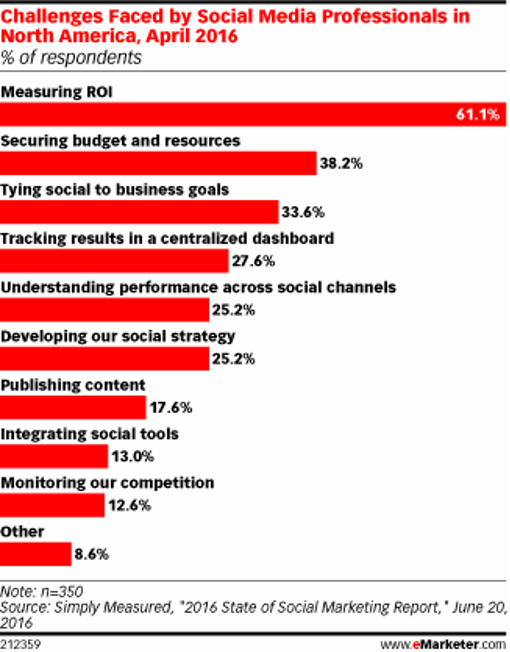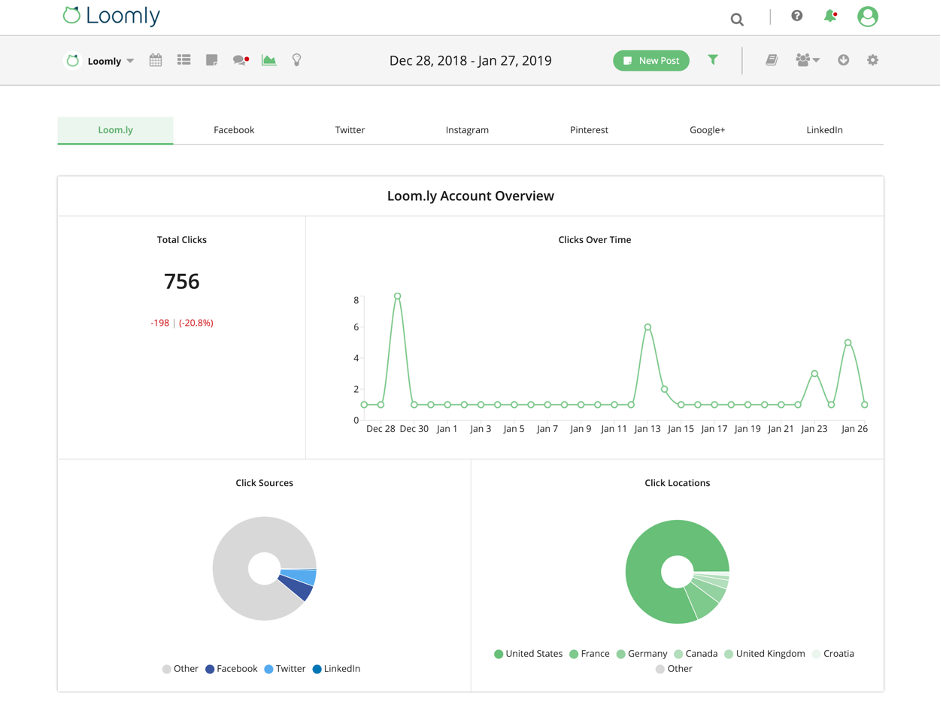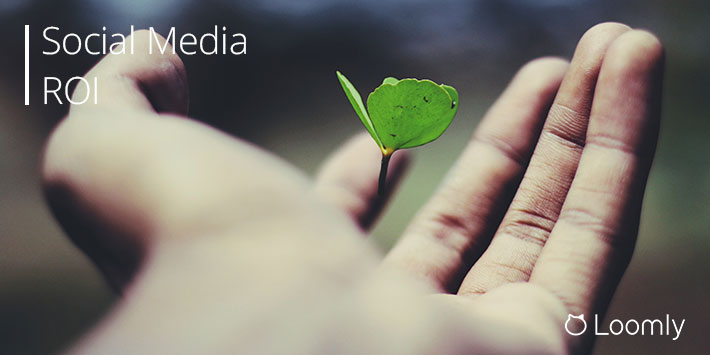Ask any social media marketer what their biggest struggle is, and they’ll tell you it’s evaluating social media ROI.
What is social media ROI? And how do you measure and prove social media to your boss?
We’ve got the answer to those questions and more in the social media ROI FAQ below, so you’ll feel confident enough to make return on investment an integral part of your strategy.
Table of contents
- What does ROI mean?
- What is social media ROI?
- Should you measure social media ROI for your business?
- How do you define social media ROI for your business?
- What is a good social media ROI for your business?
- How do you measure ROI on social media?
- How do you calculate social media ROI?
- How do you prove social media ROI?
- How do you maximize ROI on social media?
- What are the most important social media metrics to maximize ROI?
- How can social media improve ROI?
What does ROI mean?
ROI stands for Return on Investment. It’s a performance measure used to evaluate an investment’s efficiency or compare the efficiency of several different investments.
The return on investment formula is as follows:
ROI = Current Value of Investment − Cost of Investment / Cost of Investment
In other words:
ROI = Profit / Cost of Investment
What is social media ROI?
Social media ROI is a key performance indicator that reflects the impact of your social media strategy on your company’s goals.
You can apply ROI in marketing to all types of “investment”, not just money, including:
- Financial
- Time
- Resource
It aims to calculate whether the investment is well spent and that the brand is seeing adequate returns on what it puts in.
As a marketing team, your investment is almost always the time and cost of creating content, plus the cash spent on the budget for your social media campaigns. Depending on your company’s size, this will often include:
- Salaries
- Tools
- Content creation
- Advertising
- Marketing materials
- Freelancer fees
Pretty much anything you spend on making your social media strategy work.
What counts as a return is dependent on your company’s goals for social media. Possible metrics include:
- Revenue generated: Are you bringing in more income than you spend?
- Brand awareness: Is the number of people who know about your brand growing?
- Customer satisfaction: Has social media influenced how people view the company?
- Growth rates: Has social media impacted year-on-year revenue growth?
- Conversion rates: Are you convincing enough people to take the right action?
Justifying the ROI of social media is key to securing your budget for the next year, as well as understanding and refining your strategy.
Should you measure social media ROI for your business?
Yes, absolutely.
In today’s competitive social media environment, measuring social media ROI for your business is no longer optional. The growing costs of reaching your target audience mean it’s necessary to increase your budget, spend it in the most efficient way, and demonstrate its impact on your business.
Most importantly, looking into your ROI can provide you with valuable hints on how to fine-tune your social media strategy, which can effectively put you ahead of the game.
How do you define social media ROI for your business?
There’s no one-size-fits-all method of defining social media ROI for your business. Different brands have different goals. For example, some brands focus on brand awareness, while others focus on customer service.
To define social media ROI for your business, you need to identify your goals and objectives, and understand what return you want.
What is a good social media ROI for your business?
When it comes to defining a good social media ROI for your business, there’s no universal number that’s an indicator of success for any company. You should instead determine what’s a good value for your own business.
For example: Value / Investment (people hours, ad budget, etc.) X 100 = Social media ROI (as a percentage)
Value depends on your organization’s objectives; e.g. brand awareness, revenue, customer satisfaction, etc.
How do you measure ROI on social media?
If you want to measure ROI on social media, you need to combine the built-in platform analytics with Google Analytics to get a complete picture.
Social media built-in platform analytics tools
You can use each platform’s built-in analytics tools to measure social media metrics, such as engagement, likes, and shares. For example, there’s Facebook Insights, LinkedIn Company Page Insights, and Pinterest Web Analytics.
Google Analytics
You can use Google Analytics to measure how your social media actions affect the bottom line or contribute to conversions.
Its social reports can show you the impact of social actions, which social networks yield the best results, which content is most popular, and how social can result in conversions.
How do you calculate social media ROI?
Social media ROI is what you get back from all the time, effort, and resources you commit to social.
In simple terms, you can measure ROI on social media as follows:
ROI = (Return – Investment) / Investment
The formula above has two parts: Return and Investment.
Here’s how to calculate each of the two values on social media:
How to calculate your return
“Return” is one of the trickier elements of social media ROI because it can mean different things to different marketers.
It comes down to what you want to achieve and how much these actions are worth to you.
- Choose a goal – e.g. new followers, newsletter signups, online purchases, etc.
- Track your goal – e.g. track website goals in Google Analytics, track social media interactions (shares, likes, follows) with built-in platform analytics, or use a tool like Loomly.
- Assign a monetary value to your goal – e.g. how much do you earn on average from a customer?
How to calculate your investment
You’ll need to measure your investment:
- Time – e.g. labor costs and salaries.
- Tools – e.g. the costs of all the tools and services you use for social media.
- Ad spend – e.g. boosting Facebook posts, promoting Tweets, etc.
How do you prove social media ROI?
Proving social media ROI is tough.
According to eMarketer, 61% of social marketers said evaluating ROI is their toughest challenge:

Furthermore, LinkedIn research found that 58% of digital marketers have to prove social media ROI to get approval for future budget requests. But only 37% were “very confident” in their ROI metrics.
Here’s how to measure and prove social media ROI for your business.
Step 1: Define clear social media objectives
Start by defining what value, in terms of social media results, means to your brand. Clear social media objectives help you define how social actions align with business and departmental goals.
Social media investment might create value, like:
- Business conversions (such as customer acquisition or lead generation)
- Brand awareness or perception
- Customer experience and loyalty
- Employee trust
- Partner confidence
- Security and risk mitigation
Step 2: Set smart goals
Once you’ve established clear objectives that link your social media ROI to real business results, you need to set goals.
- Objectives define what and where you want to go.
- Goals define how and when you will get there.
For example:
- Objective (What): Increase awareness of our new product before it launches and take attention away from our competitors.
- Goal (How and when): Boost our social share of voice by 10% by the end of Q1.
Note: be clear about how much value each goal brings to your brand.
Step 3: Track the right performance metrics
You need to track social media metrics to determine whether you’re achieving objectives and meeting your goals.
So-called “vanity” metrics – such as likes, comments, and shares – get a bad press, but they can have value. They should only be considered “vanity” metrics if they don’t align with your business objectives. So, if you generate tons of “likes” but “likes” don’t align with your objectives, then it would be a vanity metric.
Other metrics you could track to prove social media ROI include:
- Reach
- Audience engagement
- Site traffic
- Leads generated
- Sign-ups and conversions
- Revenue generated
When deciding what metrics to use, ask yourself:
- What kinds of things does the target audience do after exposure to a campaign?
- Does this metric align with my objectives?
- Does it help me make decisions?
- Do I have the capacity to measure it effectively?
Step 4: Calculate how much you spend on social media
As a marketing team, your investment is almost always the time and cost of creating content, plus the cash spent on the budget for your social media campaigns. Depending on your company’s size, this will often include:
- Salaries (proportion of time spent by your social media team on meetings, posting and promoting content, running ads, etc.)
- Tools and platforms
- Content creation
- Advertising budget
- Marketing materials
- Agencies and freelancer fees
Pretty much anything that you spend on making your social media strategy work.
Step 5: Create an ROI report
Here are some tips for creating a social media ROI report.
- Use a template – Analytics templates allow you to track metrics without building custom reports for each campaign.
- Use plain language – Not everyone understands social media data as well as you do. So, it’s essential to present information as clearly as possible.
- Align results to the relevant business objectives – That’s why you defined them at the start of this process.
- Articulate limitations – Demonstrate what’s possible with the data you have, but be clear about what’s not possible to measure too.
How do you maximize ROI on social media?
There are two ways (at a high level) you can maximize social media ROI:
- Reduce spend: look for opportunities to save money.
- Increase impact: refine your strategy to increase the effectiveness.
Here’s how to do both of them, so you have a lean, mean ROI-generating social media machine…
1. Repurpose your existing content
You can transform your blog posts, podcast episodes, YouTube videos, infographics, product photos, client case studies, and customer testimonials into original social media updates for minimal time and effort.
2. Tag products in your updates
Sales are the most direct form of ROI you can get. And a great way to increase your sales from social media is by tagging products that feature in your updates.
Setting this up is pretty simple:
- If you host your products on a website like Shopify or Squarespace, you can do this in just a few clicks by following Instagram’s guide here.
- If you are using a content management system like WordPress, you’ll need to set up your products in a Facebook You can read more about how to do that, here.
Once completed, just tag the product in your image, and all of your followers can click directly through to the product page.
You can read more about Social Commerce in our guide.
3. Get clear on your experiments (and run one at a time)
When you plan your social media tests, focus on the single variable you are going to change – e.g. frequency, timing, content type, etc. – and assume every other variable will stay the same.
This allows you to create a quasi “if this, then that” hypothesis for your test.
For example, if we change the post timings to before 08:00 CET, then we will see an increase in European engagement.
With this hypothesis in place, you have defined the one variable you are going to change, and gained clarity about the result you are expecting to see.
4. Double down on the channels that matter
Double down on the channels where you can have the most impact, and remove any excess from your strategy.
By doing this, you can:
- Free up more budget to invest in high-ROI channels.
- Spend more time creating high-quality native content.
- Better test, track, and improve your strategy with more focused analytical data.
All of which positively impact your ROI and enable you to create a targeted, effective strategy that produces greater results.
5. Refine your social media workflow
One of the most controllable ways to improve your social media ROI is to save money on implementing your campaign
Research shows that 20 to 30 percent of a company’s revenue can be wasted on inefficient workflows.
To fix this, and free up some extra cash, you should consider implementing an efficient social media workflow that’s approved and understood by all the team members involved.
6. Track every link click possible
The more data you can have to inform the future of your strategy, the better.
One way to gain insights and understand the intent and actions of your audience is by tracking link clicks. For instance, with Loomly & Loom.ly:

Ideally, you should be tagging every link used in your social media profiles and updates so you can:
- See where your traffic comes from.
- Understand which types of posts drive the most traffic.
- Test calls to action and copywriting
You can set this up for free using UTM parameters in conjunction with Google Analytics.
However, doing this with Google Analytics can require you to juggle lots of different links and campaigns, so we have created a way to simplify it.
With Loomly, you can track all of your links in one easy-to-understand dashboard, alongside the rest of your social media analytics.
7. Plan your content further in advance
Planning your content – i.e. a minimum of two-to-four weeks in advance – comes with a lot of great benefits:
- Fewer mistakes.
- Higher quality posts.
- More consistent schedule.
- More time to accurately analyze data.
These elements all help to improve the ROI of your social media strategy by saving you money on fixing problems and giving you ample time to make data-driven decisions.
In other words, you spend less time putting out fires and stressing about tight deadlines, and more time creating an optimal social media strategy.
It’s one of the reasons we created Loomly, along with this step-by-step guide on how to create and manage your social media calendar.
What are the most important social media metrics to maximize ROI?
Your social media goals are what determine your metrics. For every goal, you need a related metric that helps determine if your social strategy is hitting the mark or not—[See previous section: How to prove your social media ROI].
All metrics have meaning. It’s about interpreting what that metric tells you and translating that back to your business goals. Some of the most important social media metrics include:
- Engagement: Likes, comments, shares, and clicks.
- Awareness: Impressions and reach.
- Share of voice: Volume and sentiment.
- Customer acquisition: Referrals and conversions.
- Customer care: Response rate and time.
How can social media improve ROI?
If you’re looking to improve your social media ROI, here are the things you must pay attention to:
- You can’t improve what you don’t measure.
- Make sure you know who is engaging with your content.
- Make sure your social media content resonates with your target audience.
- Make sure your content is seen by your target audience.
- Use social lead generation and social lead nurturing tools.
- Nurture your existing customers with social media.
- Schedule experiments into your social media cadence.
- Integrate behavioral insights from social media into your core marketing and sales workflows.

Manage all your social media accounts in one place.
Craft, schedule, & auto-post content to all your social channels, then track analytics and manage interactions from a single, easy-to-use dashboard.
Social Media ROI in a Nutshell
The concept of social media ROI can appear a tough nut to crack. But once you break it down, and align your business goals and objectives to your social media metrics, then you can measure and prove the value of your social media investment to your boss.
Follow the guidelines above to prove your social media ROI once and for all.



